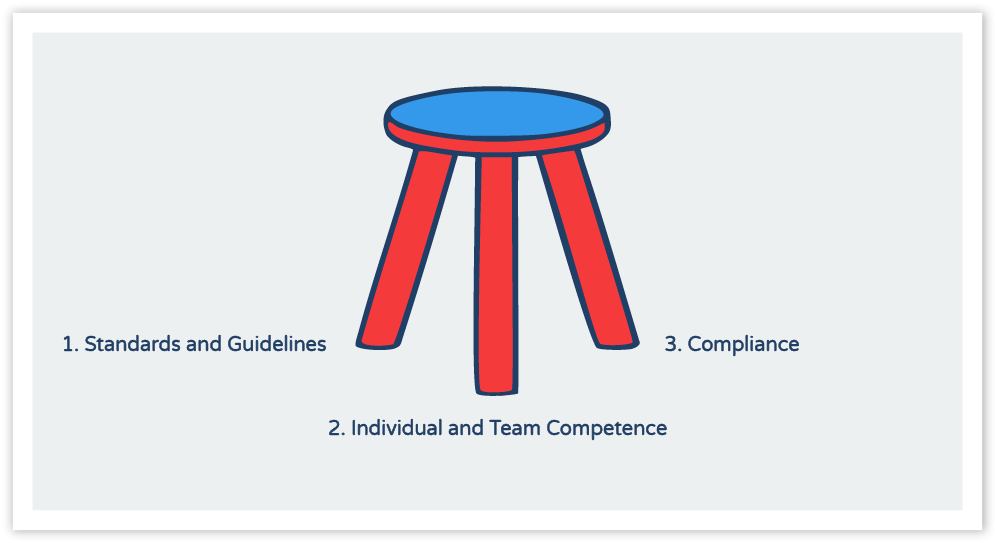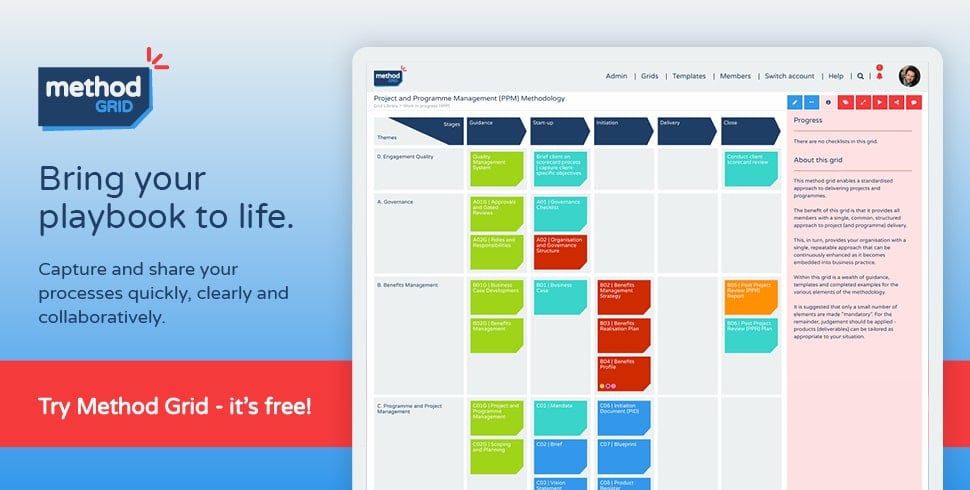Awash with soundbite - Are you a desired internal competence for your client? - Do myself out of a job? - Three legs of the stool - Large ring-binders on dusty shelves - Instilling skills and confidence - Adherence of a critical mass - Ultimate success is being not needed again
The world of professional services is awash with soundbites; there are so many phrases uttered in an unthinking, inauthentic manner and “capability transfer” is right up there with the best of them. In this blog, I want to get beyond the soundbite: to explain what capability transfer really means and to reinforce why it so important that you offer this to clients and then deliver on it!
Capability Transfer
I should say upfront that what follows is relevant to the vast majority of professional service firms but not all. If your services are truly specialized, esoteric or one-off with respect to your average client’s viewpoint (say, commercial legal support for a rare acquisition) then capability transfer may not be high up your client’s set of needs. If, however, as is the case for a very wide range of professional services, the skills you represent are arguably a desired internal competence of the clients you serve – then capability transfer should be something you focus on.
An example of this might be transformation and change practitioners. Corporate transformation is the norm nowadays so any savvy organization is going to seek to build such practices as core competencies within its own staff. Just because an organization needs such support now (for capacity or immature capability reasons) does not mean they will always wish to rely on such external intervention. So, regardless of the professional expertise you offer, you should step into your client’s shoes and ask “would they gain from having this capability internally in the longer term?”. If the honest answer is yes – and it is in the vast majority of professional service transactions – then you need to offer capability transfer and genuinely deliver on it!
Why is this?
At first, selfish review this stance would appear to “do yourself out of a job” and many myopic business leaders, naturally, think that way. The reality, however, is that the firms that deliver on capability transfer as a reliable adjunct to every support intervention they carry out always rise to the top. Such an approach builds huge amounts of client trust and reputation for authentic service cf. firms that get known for regularly outstaying their welcome. With a reputation for capability transfer being a part of your service, you will find yourself being commended to new areas of an organization beyond your immediate client/engagement scope. If your scope was such that the entire client organization is now upskilled, you will have in this client an advocate for life: someone willing to refer you into many other places. In summary, whilst you might make some short-term economic rent from not helping a client upskill, your position will inevitably unravel with respect to wider strategic opportunity, reputation and growth.
So, if you follow this logic – and I implore you too – then the first thing you will want to consider is offering capability transfer as a foundational component of how you do your business.
Let’s be honest most professional service firms do so already – but it tends to be a rather glib piece of marketing.
So, critically, to really rise above the mediocre masses, you need to understand what capability transfer truly means and build it into your service methodology and ethos.
Let’s strip it down to some basics.
To become capable in a skill/competence area, from an organizational perspective, three fundamental factors are required; let’s call them the three legs of the capability transfer stool:
1. Standards and guidelines
A common way of working, fit for purpose for the organization, clearly laid out and openly, easily accessible. Method Grid just happens to be a perfect tool for enabling this aspect of the challenge!
2. Individual and team competence
Trained and confident practitioners with the skills, knowledge and experience to deliver in the competence area in question.
3. Compliance
Adherence of the critical mass of an organization to the agreed ways of working in order to achieve the joined-up benefits.

Without all three legs in place, there is no meaningful capability in place; by example, many businesses have an accepted methodology for competence area X, and many talented/skilled staff in X but just total non-compliance – everyone largely doing their own thing. As such, a capability transfer exercise has to involve all three aspects.
How is this best done?
Delivery capability transfer – like your core offering generally – is most effectively done within a structured engagement/project management discipline. It takes careful planning and focused delivery (with clear accountabilities in place). If you are using Method Grid as your platform on which to continuously build out your professional service approach, then think of it as a row within your grid.
It is also something that you can only do by working in very close collaboration with your client – so think of a closely merged project team cf. you “doing this to them”. As a minimum, there should be active client representatives on your project team from every area of their business that you seek to impart enhanced capability to; ideally, your team is the smaller, expert-organising component within this larger client-owned and client-centric group.
With those overarching points made, let’s take each leg in turn.
Leg one – involves you helping clients develop their standardised, common way of working – in a manner that is readily accessible and easy to understand.
The first dimension of this challenge is addressing where, and how, to capture any such standard operating procedure i.e. how best to disseminate it to a large team/organization. Long gone are the days of large ring-binders on dusty shelves that no-one maintains and fewer still read. Rather, think about easy-to-access, mobile, cloud-based portals that capture process/steps/tasks in an intuitive, graphically-aesthetic manner. Know of any such platform? 😉

The second dimension is the actual facilitation and write-up of the method – ensuring it really is fit for purpose for your end client. Do not underestimate how much work this requires. If you are any good at the technical proficiency you claim to have then you will hopefully have a structured, codified way of delivering it. The skill here though is not just to copy/paste this into your client circumstance but to modify and adapt it such that it meets their language, their structures, their appetite for risk and detail. Expect multiple levels of review and edit before you have co-designed something that the client genuinely accepts and owns as their own.
Leg two – involves you both training your client-colleagues and instilling confidence in them with respect to the area of competence in question (once the knowledge/skills are there). On a large engagement this capability transfer factor can involve training-the-trainer i.e. building a team of internal agents able to disseminate the skills/knowledge across their own organization. In turn, this will require the development of structured training materials. Done well, the client organization can turn first to a growing set of internal resources before needing to look outside for expert support.
Finally, with leg three, there is a need to support clients in getting compliant with any new systems, processes or tools introduced – else all other capability transfer efforts will have been for naught. This invariably touches on matters of governance and culture. For example, you will need to ensure the leadership of an organization is on board with the new ways of working – especially so if your work was commissioned from within the organization as opposed to from the top. Are there any changes to governance constructs (management fora, reporting etc.) necessary to give oversight to this compliance? How can leadership behaviours and wider reward processes encourage compliance? What ongoing communication and community-of-practice learning events are being put in place (under the new internal team) to keep these new practices alive? You get the drift.
As you can see true capability transfer practices are involved, multi-dimensional aspects of a professional service engagement. It is certainly far more than the common notion that this is just a case of having regular, friendly chats with a client during a project – and hoping that some meaningful level of capability transfer will happen by accidental osmosis. You can only claim to deliver capability transfer if you have very predetermined, structured approaches and tools in place along the lines I suggest and, of course, the client needs to play their side to (with respect to ownership of this goal, co-resourcing, receptiveness to your approach etc).
As a final comment on this topic, I would say that if you espouse this aspect of your service then you also really need to hold yourself to account on it also. I will write a future blog on client feedback (and the use of balanced scorecards) as an aid to managing the continuous improvement of your services. Suffice to say, if capability transfer is integral to your offering, then every client should be asked on completion of your engagement: “To what degree did we leave you better able to do this work yourself in the future?” (quantitative score).
For the vast majority of professional service firms, client success will be that you are not needed again – or – certainly dependence on future external support has meaningfully reduced.
And, if you can help your clients succeed beyond your spot intervention then so too, in the long run, will your business succeed and grow to!
So, what’s next?
Next week, having raised the topic in this week’s blog, I am going to talk about a balanced scorecard process to embed in your engagement practices – as an invaluable aid for honest client feedback and continuous service improvement.
Hopefully, you’ll join us on this journey. It’s totally free, and you don’t have to be a Method Grid customer (though you’re more than welcome to sign up for a free trial here).
We’ll be releasing a new post each week. To get each post emailed to you as soon as it’s published, sign up for the Climbing Mount Audacity mailing list below.
Climbing Mount Audacity…
From Startup to Scaleup!
We're sharing everything we know about how to build an awesome professional service firm (and enjoy the journey en route!) PLUS travel updates, reflections on our stumbles and general musings on our Method Grid journey.
Signup below to get the latest articles
direct to your inbox.
See you next week. Have something you want to hear more about? Let me know in the comments below or via Twitter.

 Project and Program Management
Project and Program Management  Project Governance Framework
Project Governance Framework  Benefits Management Framework
Benefits Management Framework 







